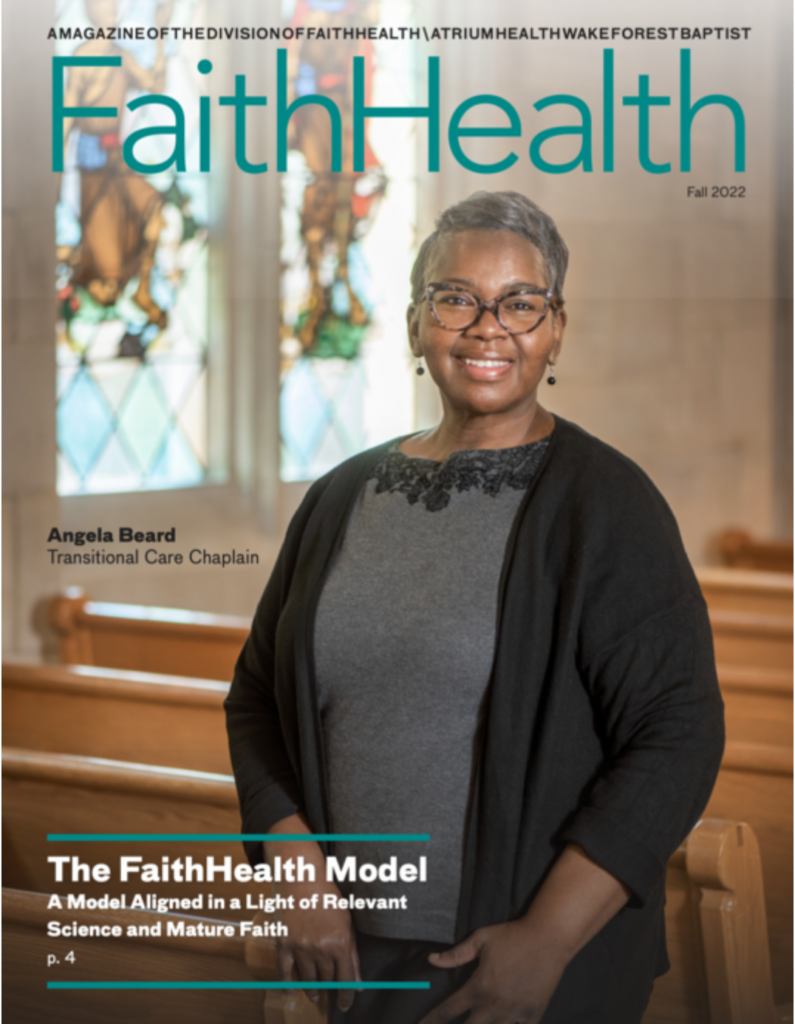By Jay Foster
The Davis Memorial Chapel, built in 1960, is an architectural gem in the medical center. The site was chosen for the central location between the medical school to the North and the hospital to the South. And the money and effort and time donated for the chapel was for one thing—to provide a sanctuary, for worried patients, for grieving family members, for busy staff.
If the chapel walls could speak, the prayers of countless souls would cry out.
Times change
Times change. The Medical Center has grown, and it has grown away from the chapel… once at the center of the campus, Davis Memorial Chapel is now on the perimeter. The fact is that patients and family members have to ask directions to even find the chapel.
Times change. For 27 years, the scope of my ministry has been focused in the medical center. Inside the walls of this 5 million square foot fortress (the place a colleague in Cancer Patient Support Services calls the Kingdom of Suffering and Science), the most god-awful kinds of crisis and trauma are in our face every day. A steady diet of terminal illness, elder abuse, domestic violence, drug addiction and gun violence is surely enough for anyone’s plate.
In the last 24 months, this focus has been challenged. The menu has grown.
Gary Gunderson arrived two years ago to lead the division, renaming “Pastoral Care” as “FaithHealth NC” to show that the ministry is not confined to the medical center complex but must encompass the communities in which people actually live their lives. People don’t come here to get well, Gary points out; they come to the Baptist for treatment, they return home to get well.
When I arrived here for a first year of Clinical Pastoral Education, or CPE, residency in 1986, I was taught that the context for pastoral conversation is bounded by time and by space. Conversation about the crisis of hospitalization is driven by the trauma of the now, and the fear of what may be coming. The skills of the listener are required to keep the intimate space open, safe enough to say the hard thing, strong enough so folk can cry aloud when words are too hard to express.
Bounds of time and space
When I moved from CPE resident to CPE supervisor, I taught what I knew. I have often pointed out to anxious groups of new interns that the walls of the medical center were their best friend. Yes, terrible trauma unfolds here, but here we have the best tools at hand to address almost any situation. Here, the physician staff delivers the bad news, the nursing staff deals with every logistical twist and turn, and security is on hand for the out of control and the drunk and disorderly. Here, the pastor can focus on the trouble at hand because the walls of the hospital block out a space in which to work. Out in the community, where the crisis and the trauma originate, the boundaries are much less clear. Out in the community, the pastor delivers the bad news, the pastor copes with the logistics, the pastor manages security.
So, attention to bounds of time and space is still needed for the pastoral conversation outside these walls; it is simply a bigger job. Here is what I mean. The pastoral counselor counts on her or his contract with the client, as well as the bounded space of the 50-minute hour, to create a safe and critical environment for therapy to occur. The counselor pays close attention to avoid any dual relationship with the client. The counselor is not going to socialize with the client, for instance.
The chaplain inside the walls of the hospital, similarly, counts on her or his position as a member of the health care team, as well as the relatively bounded space of the patient visit, to invite the patient or family for conversation and prayer at the bedside. The chaplain pays attention to dual relationships, and is thoughtful and attentive when these arise. Does a fellow church member want a visit from me in the hospital, for instance? And if so, am I there as hospital chaplain? Or as friend? Both?
The pastor in the congregation counts on her or his role within the faith community, as well as the context of the pastoral encounter, to inform the goal of this or that particular pastoral event. When a friend and a congregant asks for a minute at the potluck supper, and begins to unload about a skirmish on the board of elders or even about an extra-marital affair, the pastor does well to take a good minute to size up the needs of the congregant relative to her or his role at the dinner, and figure out which hat to wear.
New mission, new hat, back into the world
As members of FaithHealthNC, we in chaplaincy and across the division are learning to wear a new hat. As clergy working on the border between medical center and community, I think we have a lot to learn about how to manage the important boundaries of the pastoral conversation in terms of this new role, goal and context. The new mission is to build solid pathways between patient need and congregational resources in the community, and accompany people in need along that path. The goal is clear enough; learning how to attend to various roles and contexts is I think where we need to learn.
Geographically speaking, the chapel’s current great advantage is that the hallway leading to and from the main employee parking deck goes right by the chapel doors. When I come in the morning, and as I leave in the evening, staff members are often at the altar, or just inside the Narthex, offering a prayer for the day.
So, the location of the Davis Chapel may be in just the right place—on the edge of the campus, the chapel can be a boundary space between medical center and community; on the path from the parking deck to clinic, the chapel can anchor a sacred space, to pause for prayer on the way into the medical center, and back into the world.
Jay Foster is Associate Director, Chaplaincy & Pastoral Education.

